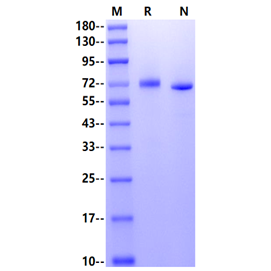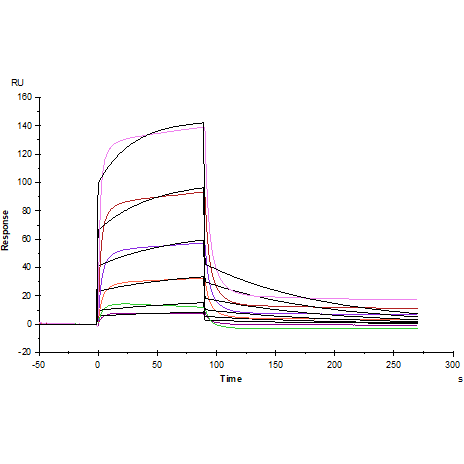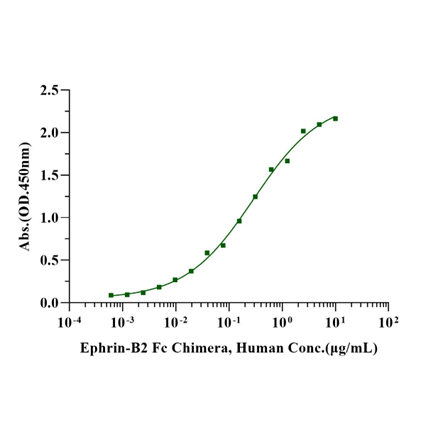1μg (R: reducing condition, N: non-reducing condition).
Product Details
Product Details
Product Specification
| Species | Human |
| Antigen | EphB6 |
| Synonyms | EC 2.7.10.1, EPH receptor B6, EphB6, ephrin type-B receptor 6, Hep, Tyrosine-protein kinase-defective receptor EPH-6, Mep, MGC129910, MGC129911 |
| Accession | O15197 |
| Amino Acid Sequence | Leu32-Ser594, with C-terminal 10*His LEEVLLDTTGETSEIGWLTYPPGGWDEVSVLDDQRRLTRTFEACHVAGAPPGTGQDNWLQTHFVERRGAQRAHIRLHFSVRACSSLGVSGGTCRETFTLYYRQAEEPDSPDSVSSWHLKRWTKVDTIAADESFPSSSSSSSSSSSAAWAVGPHGAGQRAGLQLNVKERSFGPLTQRGFYVAFQDTGACLALVAVRLFSYTCPAVLRSFASFPETQASGAGGASLVAAVGTCVAHAEPEEDGVGGQAGGSPPRLHCNGEGKWMVAVGGCRCQPGYQPARGDKACQACPRGLYKSSAGNAPCSPCPARSHAPNPAAPVCPCLEGFYRASSDPPEAPCTGPPSAPQELWFEVQGSALMLHWRLPRELGGRGDLLFNVVCKECEGRQEPASGGGGTCHRCRDEVHFDPRQRGLTESRVLVGGLRAHVPYILEVQAVNGVSELSPDPPQAAAINVSTSHEVPSAVPVVHQVSRASNSITVSWPQPDQTNGNILDYQLRYYDQAEDESHSFTLTSETNTATVTQLSPGHIYGFQVRARTAAGHGPYGGKVYFQTLPQGELSSQLPERLSGGGSGGGSHHHHHHHHHH |
| Expression System | HEK293 |
| Molecular Weight | 70-72kDa |
| Purity | >95% by SDS-PAGE |
| Endotoxin | <0.1EU/μg |
| Conjugation | Unconjugated |
| Tag | His Tag |
| Physical Appearance | Lyophilized Powder |
| Storage Buffer | PBS, pH7.4 |
| Reconstitution | Reconstitute at 0.1-1 mg/ml according to the size in ultrapure water after rapid centrifugation. |
| Stability & Storage | · 12 months from date of receipt, lyophilized powder stored at -20 to -80℃. · 3 months, -20 to -80℃ under sterile conditions after reconstitution. · 1 week, 2 to 8℃ under sterile conditions after reconstitution. · Please avoid repeated freeze-thaw cycles. |
| Reference | 1. Surawska, H. et al. (2004) Cytokine Growth Factor Rev. 15:419. 2. Poliakov, A. et al. (2004) Dev. Cell 7:465. 3. Wu, J. and H. Luo (2005) Curr. Opin. Hematol. 12:292. 4. Pasquale, E.B. (2005) Nat. Rev. Mol. Cell Biol. 6:462. |
Background
EphB6, also known as Hep and Mep, is a 110 kDa member of the Eph receptor tyrosine kinase family. The A and B classes of Eph proteins are distinguished by ligand preference and have a common structural organization. The human EphB6 cDNA encodes a 1006 amino acid (aa) precursor that includes a 16 aa signal sequence, a 563 aa extracellular domain (ECD), a 21 aa transmembrane segment, and a 406 aa cytoplasmic domain. EphB6 is primarily expressed in brain, pancreas, thymus, and peripheral T cells. EphB6 forms stable heterodimers with EphB1 and participates in signal transduction by association with other enzymatically active molecules. Binds to ephrin-B1 and ephrin-B2. Modulates cell adhesion and migration by exerting both positive and negative effects upon stimulation with ephrin-B2. Inhibits JNK activation, T-cell receptor-induced IL-2 secretion and CD25 expression upon stimulation with ephrin-B2. The level of EphB6 expression is inversely correlated with tumor aggressiveness in a variety of malignancies. EphB6 also functions as a T cell co-stimulatory molecule. EphB6 clusters with the T cell receptor and participates in the subsequent attenuation of the T cell response.
Picture
Picture
SDS-PAGE
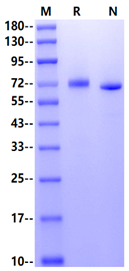
ELISA
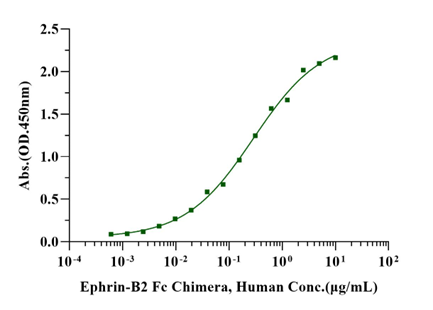
Immobilized EphB6 His Tag, Human (Cat. No. UA010602) at 2.0μg/mL (100μL/well) can bind Ephrin-B2 Fc Chimera, Human (Cat. No. UA010160) with EC50 of 0.22-0.39μg/ml.
SPR
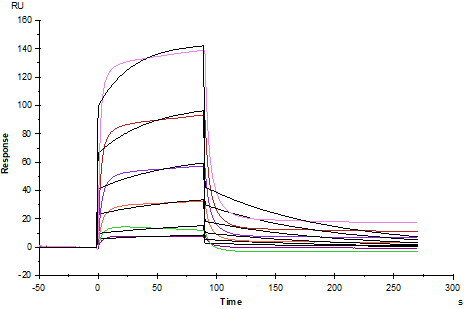
Protein A Chip captured Ephrin-B2 Fc Chimera, Human (Cat. No. UA010160), can bind EphB6 His Tag, Human (Cat. No. UA010602) with an affinity constant of 0.20μM as determined in SPR assay.
